Original Kit:
New Monkees Mustang GT Convertible
Made By:
Monogram (kit #2771)
Scale:
1/24

eBayPartner Affiliate Link
Other 1980s TV Models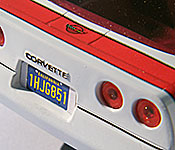
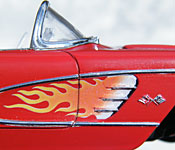
Other Music Models
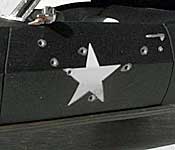
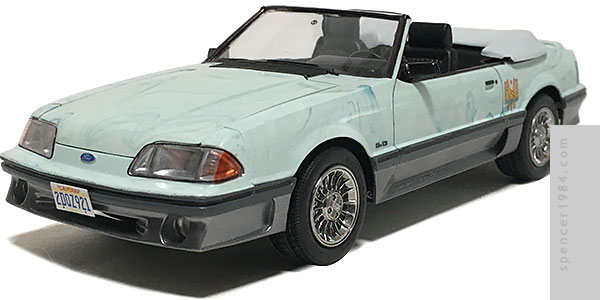
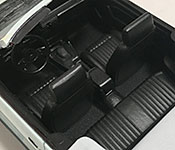
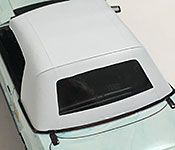
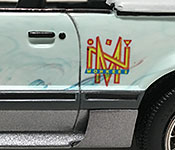
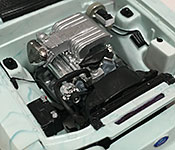
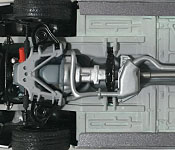
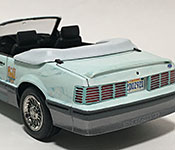
As part of a 20th anniversary celebration of The Monkees in 1986, MTV ran a marathon of their show that prompted a resurgence in popularity. Eager to revisit the success of that earlier series, New Monkees was put into production with an all-new group, new setting, and new "Monkeemobile." Rather than a full custom as was created by Dean Jeffries for the earlier show, this crew rode in a fresh-for-1987 Mustang GT convertible with Ford's updated "aero" look and a custom marble paint job. Monogram joined in the hype, updating their existing Fox Mustang and releasing it in New Monkees packaging.
Well, sort of.
As it turned out, the only thing Monogram actually updated was the body and wheels. The kit still had the old interior with its 1970s-era dashboard, the same carbureted engine that Ford had discontinued the previous year, and the same chassis with its single exhaust pipe terminating in dual tailpipes. So whether you wanted to build the pre-87 Mustang or the Aerofox, at least half of the kit was sure to disappoint. About the only thing it had going for it was the plastic itself, as the kit was molded in a swirly blue-green that roughly approximated the marble finish on the 1:1 car.
At some point after purchasing the kit, I located an updated interior and correct intake manifold from a later Revell release. This got me everything I needed, or at least close enough (more on that in a bit), so I set to work.
Surprisingly, considering the halfhearted weirdness of the kit, it went together easily. Fit and finish were excellent, with little cleanup needed and just about everything having nice positive locators. I gave the chassis a light spray of gray primer up the middle, which both mimicked the factory paint application and allowed me to paint the driveshaft tunnel (molded as part of the interior bucket) so that it matched the surrounding floor. Details were picked out in various blacks and metallics. The wheels were given a light coat of Tamiya TS-71 Smoke clear to knock off the plasticy look of the chrome plating. I kept the single exhaust, since fixing that would mean having to replace the chassis pan as well and I wanted to keep the marbled floor.
The engine was painted TS-32 Haze Gray, which looked to be a "close enough" approximation of Ford's engine color at the time. The stock headers were retained so that they would connect properly to the exhaust pipe, but I did replace the intake with the correct fuel injection unit. It was only after I had the car together and was doing the final assembly that I found that not all of the body had been remolded: the engine bay still reflected the older style, with the battery on the right fender where the cold air box was supposed to mount. Too late to fix it, and likely unable to do so without ruining the area even if I had caught it earlier, I opted to give it a custom intake with a triangular air cleaner from AMT's Mustang II kit.
The interior was simple enough, painted satin black with my own gauge faces. Getting it installed was a bit tricky, though, in part because Revell/Monogram had changed their tab arrangement sometime between the releases of the two kits I was working with. It was one of the few places without good locators to begin with, so without even those I was left to do some guesswork. I opted to glue it to the chassis, where there was a slightly better chance of getting it correct, then working the body down around all of it.
I left the top half of the body unpainted, but cleaned up the few parting seams and gave it a good polishing. The lower half was done in TS-42 Light Gunmetal with a TS-4 German Gray rub strip and Hasegawa Flat Black Finish inserts. Because the chassis was designed for the body without side skirts, there was a pretty good-sized gap on either side between the two. To fix this, I made filler panels from 0.030" styrene stock and painted them to match the rockers. Folk Art's "Dutch Aqua" was a decent enough match to the body for me to paint the taillight grids, and the rest of the trim was done with various blacks. Both the up-top and boot were base painted with AS-5 Light Blue to even out the swirly texture then hit with white primer for a satin finish. The headlight buckets were first painted with Molotow Liquid Chrome, then the lenses were detailed with Sharpies for the tinted areas and gaskets. Finally, the Ford badges were aftermarket decals and the license plates and door decals were my own prints.